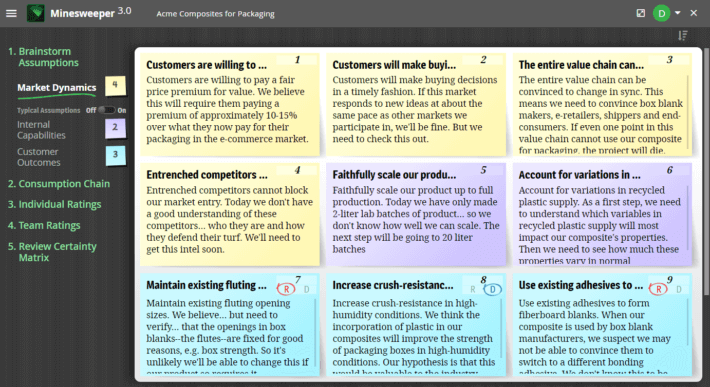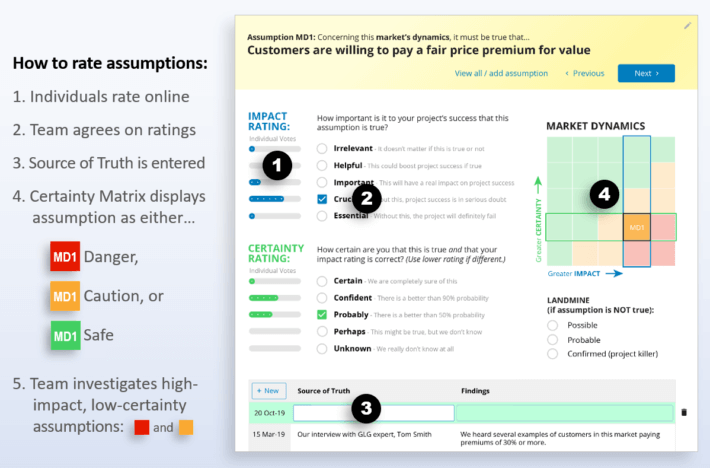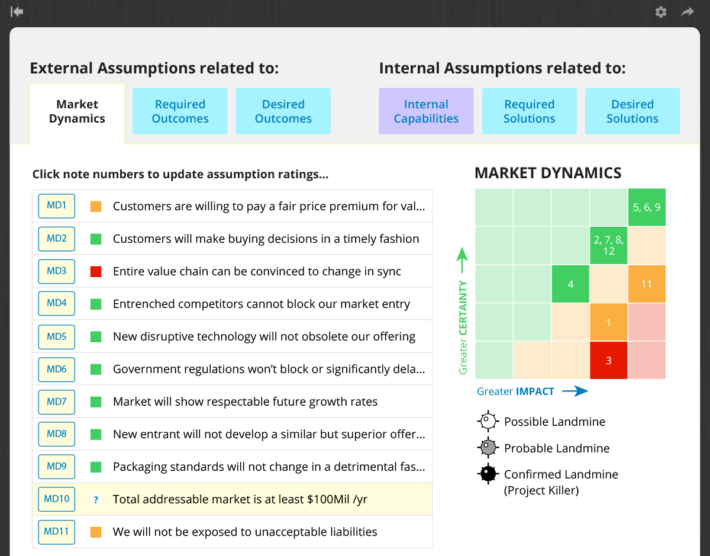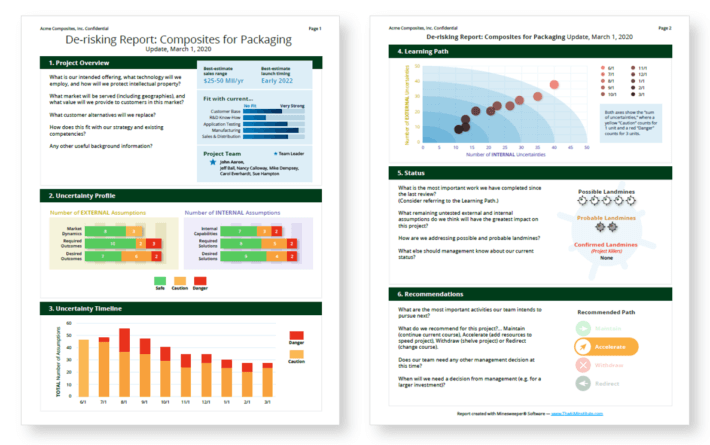Project De-risking with Minesweeper® Software
A big benefit: When you think of your big high-stakes projects, do you have a sense of peace… a feeling of complete confidence? Or do you recall past project disasters? With our project de-risking methodology, your team has an “insurance policy,” so you’ll either win big… or kill your project quickly. (For more context, view the video above, or download the white paper, Innovating in Unfamiliar Markets.)
A second benefit: Minesweeper software lets you communicate project risk clearly to management, and intelligently engage them in investment decisions. No more, “trust us… this will be just fine.” Here’s a sample of the report your teams can generate with Minesweeper® software to update management on their progress.
Risky… or just uncertain?
Most companies treat high-stakes projects as “risky” when they should treat them as “uncertain.” Risk is the probability of a negative occurrence. When you first decide to pursue an unfamiliar market, you don’t know enough to assign this probability: You simply are uncertain. Good project de-risking is really a learning process… moving from uncertainty to certainty.
It’s dangerous to pursue this market “no matter what.” A more intelligent approach is to gather all assumptions, drive the important ones from uncertainty to certainty, and kill your project if warranted. There’s a lot of data to manage, but that’s where Minesweeper software helps. Here’s how your team applies project de-risking to your real project…
Good project de-risking is really a learning process… moving from uncertainty to certainty.
De-risk a real project with an AIM Coach
An AIM Coach will serve as your team’s personal facilitator to teach you to apply the de-risking methodology to a real project. He/she will take your team through the four major phases of Minesweeper de-risking:
- Generate Assumptions: The team begins by brainstorming as many assumptions as possible. These are divided into Market Dynamics, Internal Capabilities, and Customer Outcomes (yellow, purple & blue sticky notes in the illustration below.) Special triggers, e.g. a consumption chain, and our master list of typical assumptions ensure a complete list.

Generate project assumptions that “must be true” for project success - Rate Assumptions: Each assumption is rated for its likely impact on project success and current level of certainty: Individual team members rate assumptions online, to prevent “group think.” The team then 1) reviews histograms of individual ratings, 2) reaches agreement, 3) records its “Source of Truth” and 4) reviews 6 “Certainty Matrices.”

The team rates each assumption for likely impact and certainty. - Investigate Assumptions: The team then prepares a CheckPoint Plan… a series of tasks to better understand each assumption and move it from uncertainty to certainty. In the screenshot below, an assumption might “move up” from the red Danger zone to the yellow Caution zone, and eventually into the green Safe zone.

Your goal: Move assumptions “up” from uncertainty (red or yellow) to certainty (green). - Report to Management: As important as the above steps are, it’s just as important for your team to communicate well with management. Instead of confusing them with unique, “home-grown” presentations, begin using a common format—the Minesweeper De-risking Report.

Update management with Minesweeper’s 2-page De-risking Report
Consider the power of this last step. Instead of confusing management with a myriad of details, you focus their attention on the assumptions that matter. Your project de-risking engages all of leadership—from the CTO to the CFO—on the timing and investment needed to move forward. Gantt charts are great for managing timelines and resources. But what about risk? Think of this as the “Gantt chart for risk.”
Next steps…
It’s easy to begin applying Minesweeper De-risking in your company: You just need a project and project team to get started. We’ll provide an AIM Coach as a facilitator so your team can learn the methodology working on this real project. It’s typical to have four 2-hour virtual coached team sessions.
The cost is about $10,000 and your team will have a powerful CheckPoint plan, amazing reports to show management, and the skills to apply to other projects. (After the first year, software renewal is $30/person/year.)
Is $10,000 expensive? Depending on the size of your team, your weekly burn rate could be this high. Wouldn’t it be wise to make sure the team is driving hard toward the finish line without fear of unwanted landmines?
For more information, contact us to learn more about Project De-risking training options.